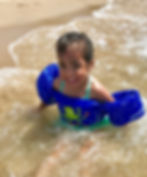Water Safety 101: A Pediatrician’s Guide to Keeping Kids Safe Around Water
- Dr. Ashley Loboda
- Jun 23
- 3 min read
As the temperatures rise, families flock to pools, lakes, and beaches for fun in the sun. While water play can be a wonderful way for kids to stay active and cool off, it’s also important to remember that water can be dangerous — even for experienced swimmers.
As a pediatrician and a parent, I know how crucial water safety is for kids of all ages. Drowning remains one of the leading causes of unintentional injury-related deaths in children, especially those under 5. The good news? With the right precautions, most water-related injuries are entirely preventable.
Here’s what every parent should know to help keep their child safe around water this summer:

1. Always Supervise, No Exceptions
Even if your child knows how to swim, never leave them unattended in or near water — not even for a moment. Drowning can happen silently and quickly. Designate a "water watcher" (a responsible adult) who avoids distractions like phones or conversations while supervising.
2. Teach Swimming Early, But Don’t Rely on It
The American Academy of Pediatrics supports swim lessons as a layer of protection against drowning. Children can begin lessons as early as age 1. But remember — swimming skills do not replace supervision or other safety measures.
3. Secure Home Pools and Hot Tubs
Backyard pools should be fully fenced with a self-closing, self-latching gate on all four sides. Hot tubs should be locked when not in use. Consider installing pool alarms for added protection.
4. Use Life Jackets — Not Floaties
For lakes, rivers, boats, or even at the beach, children should wear a Coast Guard-approved life jacket — not water wings or inflatable toys, which can give a false sense of security. Life jackets are especially important if your child is not a strong swimmer.
5. Know the Signs of Drowning
It’s not always the flailing you see in movies. Drowning is often quiet — a child might slip under water without a sound. Watch for subtle signs: struggling to keep their head above water, trying to roll onto their back, or looking panicked.
6. Practice Drain & Pool Safety
Pool and spa drains can create strong suction. Teach kids to avoid drains and make sure all pools your child uses have anti-entrapment drain covers. Long hair should be tied up, and avoid loose-fitting swimsuits near drain areas.
7. Learn CPR
Seconds count in a drowning emergency. Take a CPR class for children and infants — it could save a life while you wait for help to arrive.
8. Stay Weather Aware
Never swim during a thunderstorm. Lightning can strike water and travel long distances. If the weather looks questionable, it’s best to stay out until it clears.
Your DPC Pediatrician Is Here for You
One of the benefits of Direct Primary Care is that you can reach out to me at any time — whether you’re wondering about swim lessons, life jacket sizing, or just want a quick water safety refresher. Send me a message or schedule a quick check-in if you’d like personalized guidance before your next trip to the pool or beach. I’m just a text or call away — one of the many perks of personalized, connected care. 💙
Let’s make this a safe, splash-filled summer for your family!


